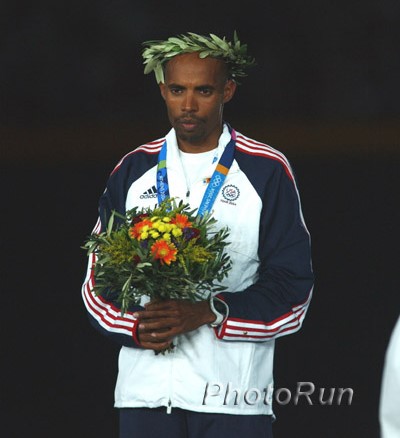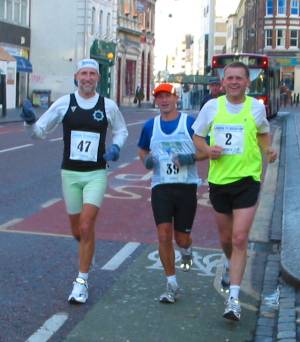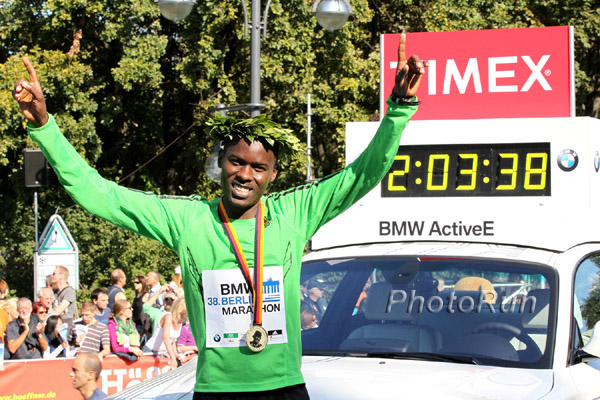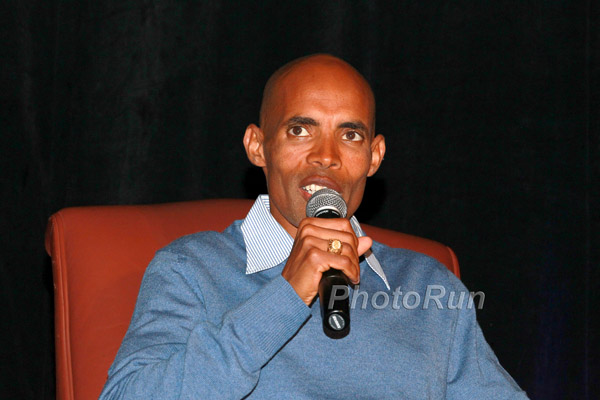Every Breath He Takes: An Interview with Veteran Endurance Athlete Jim Phelan
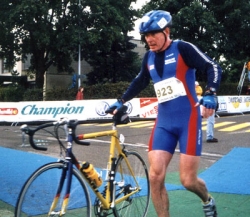
Jim Phelan is a deep thinker about endurance sport, developing his interests in duathlon and triathlon from a base as a track, cross country and road runner for Blackheath and Bromley Harriers, a British club founded in 1869 and based in south London. Now 58, he performed with distinction at the World Duathlon championships in New Zealand in 2003, finishing in the mid 20s in his age group and as second Briton in that category. He has competed in four Ironman triathlons, with a best time of 10:52, achieved in his debut, at age 50, at Roth in Germany. He took up running at the age of 28, having been “pretty inactive” till then.
What marks Phelan is the attention he has paid to technique and, through that, to improved use of the breath. That process began in earnest when injuries led him to add swimming and cycling to running. Initially, he was, by his own admission, a “lousy swimmer,” but now, almost a decade later, his swim times continue to improve.
Jim and his family live in a late Victorian house, built in 1881, in a south London suburb. This interview was conducted in mid May in the basement room where he works as a freelance graphic designer, specializing in what were LP covers and are now CD booklets. He has an encyclopedic knowledge of the Beatles and pop music in general, and the walls of his work room are covered with records, books and various paintings of music and sporting themes. It has the feel of an Aladdin’s cave, full of fascinating stories to be discovered. I found Jim’s experience as endurance athlete equally rewarding, discussed over tea and biscuits.
How did you go from being someone whose only sport was running to a triathlete?
Jim Phelan: I did track and field for years. I started out doing [long] distance stuff, and I really enjoyed the faster stuff, and I found I was doing track and field when other people were retiring. I managed to do the British championships at middle distance. [Editor’s note: Events in the 800m – 3,000m range.] Then as I got into my late 40s I was slowing down and I couldn’t do that sort of training, and I noticed that a lot of people who were about the same sort of times, whenever they came back [from injury] they always had this session, for example, “I used to do 6 x 400 meters in 62 seconds, and if I could only get back to that.” Of course, you could only get back to that for one week and then you’d get injured.
I was training with a group of people who were triathletes. I’d go out for a 10-, 15-mile run with them on a Thursday, and then again on a Sunday, and what I noticed is that I’d be running at 85 to 95 percent in my quality training sessions, and I was getting a series of calf injuries, and everything they were doing was at a less intense pace—they were probably doing it at 80 to 85 percent for the quality sessions. But whereas I was getting, say, 6 or 7 hours’ cardiovascular work a week and couldn’t do anymore because of the stress on my knees, ankles, calves and so on, they were getting 10 to 12 because it was spread out over the cycling. So the first thing that happened was that I got myself a turbo [wind trainer], so when I did get an injury, I could do the sessions on the turbo. But I discovered I couldn’t do the intense sessions on the turbo, like taking my pulse up to 120, 140, because my quads hadn’t developed—you don’t develop your quads when you’re running, but you need them on the bike. I’d be at 120 beats per minute on the bike—my legs had the energy in them and the body and lungs were fine, but my quads packed it in at that point.
How long did it take to feel, “I can make decent sense of all three disciplines from being a runner only?”
Jim: It took a good few years. For a start, I was a terrible swimmer—I couldn’t manage more than a couple of lengths without getting out of breath.
I went along to [watch] an Ironman with a group of these athletes. Firstly, I couldn’t get my head round how you could sit on a bike for five or six hours. The other thing was this swimming, at that intensity, that long, for 2.5 miles. I thought, “I’ll never be able to break the two-hour cut-off for the swim,” because there is always a two-hour cut-off, so I didn’t even think I’d be able to do it.
But then I started swimming using a pool buoy, improving my stroke, getting some drills in, and went from doing 30 lengths in an hour to doing 40 lengths, then 50 lengths and I stuck at it. I went twice a week, one hour per session, and after about two years I managed to get my mile time down to 40 minutes. [A couple of weeks before this interview, Jim achieved his best swim time for the mile in training with 27:25, without a buoy. His previous best in training was 27:29, with a buoy.]
You mention breath in connection with swimming, and how that was very important. How did improving your breath for swimming carry over into endurance sports in general?
Jim: The thing that fascinated me about swimming was that it was nothing to do with strength; it was all to do with efficiency. When people say to me now, “Oh, I can’t swim,” I say, “It’s not to do with fitness, it’s about utilizing everything. If you can get everything right, you don’t have to be that fit to swim fast.” Sometimes when I’m swimming there are little kids who swim past me, although I’m now quite a fast swimmer; it’s because they’re using everything efficiently. So the first thing you learn to do is to find out where you are and find out you want to be. So let’s say I’m swimming a length in 30 seconds, and it’s taking me 16 strokes. I’ll analyze that and say, “What I want to do is to swim the length in 25 seconds and in 10 strokes.” Therefore, my swim stroke has to become more efficient, it has to get me further each time, so then you’re getting into how much pull you’re getting with your arm, each time your arm comes over, how straight your body is, what your feet are like, and with each of these improvements there is a drill which will teach you how to do this.
What you find is, whereas then I was taking 16 strokes and now I can do it in 10, your lung capacity increases, your breathing rhythm improves. Now I can swim a mile in 27:25 and get out of the pool without being in a completely breathless state. So it’s about maximizing efficiency.
What first interested me when you mentioned this was how you described that you can now breath less. When people are under pressure in competition, they tend or seem to breath more, even panting. How did this ability to breath less carry over from swimming to running?
Jim: It’s something you only notice if you were not a swimmer. If you were a natural swimmer and then came to running and cycling, you would take it for granted that that was what you could do, that was your rate of breathing. Say I’m running 7:30 mile pace and I can listen and say, “I’m not working.” In the marathon in particular, you’re overtaking people who are panting and grunting. Now obviously your legs can be sore, but the breathing part of it, the efficiency, doesn’t come into it.
One of the things I’ve noticed recently: we went camping and we have these big, blow-up beds and I know it usually takes me 16 breaths to blow one of these up. It only took me14 this year! So obviously I’ve increased my lung capacity. And since I’ve been swimming, my chest is about two to three inches bigger than it ever was, so that’s obviously a by-product of swimming.
Let’s look at the three disciplines of the triathlon. As you’ve grown older, have there been changes in you deciding that you might need to work at one more than another?
Jim: What you have to do is to practice continuous self-analysis. You build up a base. Now my base for swimming is 3.5 to 4 miles a week, and if I’m swimming efficiently, then that’s all I need to do. Running is 30 miles a week; if I can do that, that’s fine. The bike is a big problem, because to do middle distance [triathlon], you can get away with a little bit of quality, but with the longer events, you have to get out and do 100-mile bike rides, and that is a grind and it’s anti-social, unless you’re prepared to get up at 5:00 on a Sunday morning, and that’s what I’m remiss on. What happens continuously is that you say, “My swimming is fine, I need to work on the cycling.” Whichever one you’re doing least of is the one you have to work hardest at.
In a few weeks you’ll be doing the Austrian Ironman. What does your training look like in preparation for this? Do you plan peaks, or is it the same every week?
Jim: It’s a matter of necessity. I need to do at least 100 miles a week on the bike, probably double that to be honest, 30 miles a week running and 4 miles in the swim. So that means the 10-week period before the Ironman, I’m doing about 10 hours a week training; the rest of the year, I’m averaging about 6 or 7 hours a week. A lot of people talk about 20-hour schedules for the week, but to be honest, I’d be worn out. I recently went off on a training camp to Lanzarote, and we did 22 hours in a 6-day period, and that was great, three disciplines a day, but I couldn’t have kept it up for a lot longer.
Going back to that 3:34 you ran in London last month. Your Ironman best is 10:52. Does a marathon feel very short, especially because you’re only doing one thing?
Jim: Ironically, it’s almost the other way round. If you do [the marathon] as a race, you damage yourself far more than you do over the course of an Ironman. In the Ironman, you see, everything is paced. A lot of the top athletes will do it on a heart monitor, so you say, “I’ll do it in my maximum efficiency zone, and I’ll be only between 140 and 150 bpm.” They’ll set the bleeper and stick to that, and that’s the way to do it. But in a marathon you’re caught up by what’s going on, and you are racing.
We’re talking in the room where you work as a graphic designer. I notice that you stand when you work, and presumably that could be a working day of quite a few hours. Is that part of your training?
Jim: I’d never really thought about this until somebody else pointed this out recently. I have always stood in all the jobs that I’ve done: I was a bus conductor for a while, then a teacher for ten years. Because I do endurance events, what I find is that you get stamina, you get the taste for stamina and a challenge. If there’s a difficult job, you see it as a challenge; you never think, “I can’t do that.”
In terms of time management, if I’ve got a deadline—and I’ve always got deadlines—I can get up, 6:00 in the morning, because I’m used to getting up quite early for these races. And then, because I work from home, I can work through till 7:00 or 8:00 in the evening because you’ve got that endurance from the sport, and that crosses over into your lifestyle.
I’ve heard you say that now, aged 58, you’re fitter than you’ve ever been. Your times may be slower in some cases, but how do you perceive that?
Jim: I suppose it is down to actually analyzing performances and knowing what you could do at certain stages. Also, being aware that by improving your efficiency in certain areas, you can actually get faster at swimming, get faster at cycling.
I’ll go to a cycling time trial and there’ll be some chap there in his 60s. When you first turn up at these things, you think, “What’s that old boy doing here?” We set off at one-minute intervals, and you set off three minutes ahead, and after ten miles, he comes shooting past you, and you learn a bit of respect then. These guys are maximizing their muscle potential. You’re not pounding on your legs, you’re not pounding on your heels. It’s a super-efficient motion that they’ve got; they’re using the whole cycle of the rotation of the pedals so they’re pulling up with their heels as well as pushing down, so there is no stomping on the pedals. They’re using a high cadence; you’ll find their cadence will be up to 90 or 110, which makes the bike roll.
Is there a lesson, not just for you but for all of us who are mature, that efficiency of movement is the key for enabling us to do whatever sport we want and, indeed, to help us improve?
Jim: Yes, I think so. I think if you’ve got some sort of feedback by keeping a training diary, writing down the precise sessions that lead to whatever degree of success you might achieve. Then, the following year, if you want to get back to that point, you look at what you were doing the previous year, you realize that each session has got to have a point. There’s no point in going down to the pool and swimming 100 lengths or 200 lengths if you’re going to swim with the same stroke, because if you’ve got a deficiency in your stroke, all you’re going to do is swim with that deficiency.
So what you have to do is continually self-analyze, and then each session will consist of a warm-up, a series of drills to improve one aspect of the swim, then a quality session, perhaps 20 times 50 meters or 2 times a half mile and then a warm-down, so you come out of the pool knowing you’ve achieved something in that session. You make a note of it, what you felt.
It’s the same with the running. Every week for the last 20 years, I’ve done a quality running session in Dulwich Park [a south London park, close to Phelan’s house]. We do 3, perhaps 4 times 1 mile with about one and a half minute’s recovery. Initially they were all done on the heart monitor, so there was a bit of science behind it, but now they’re done on feel. What we find is that you may have a series of injuries, you come back, you do the warm-up, you probably start off with three at 7:00 mile pace. If you’ve done that, you know you can come back next week and do three at 6:50 pace, and the week after that, three at 6:30 pace, because they feed on themselves.
The efficiency comes from that so eventually I can get down to about 6:00 pace, 6:10, and I don’t want to go any faster than that in case I get injuries. But the knowledge that each of those sessions feeds the following session is a great thing to have. Some of the younger guys who have come down there for the session, they’ll set off like a rocket, they’ll set off at 6:00 mile pace, and then the next one will be 6:30, and the next one will be 7:20. You say, “No, no, the idea is that you do all three at exactly the same pace or within two or three seconds of each other.” That, I suppose, is the efficiency of running.
This is what I’m trying to do the whole time. On the bike, when I do turbo sessions, I’ll have previous sessions which I’ll put up on the screen, and I’ll try and match that session. All the time I’m on the bike, I’m racing against myself. There’s one particular circuit on there which is 60 laps and all five riders I’m riding against are myself, my five previous best times. Each time I get on and do that session, I have to try and beat myself. I know that if I can take just one second off, I know I’ve achieved something.
Mentally, if you are continually achieving, you realize that there aren’t any sort of boundaries. It’ll be horrible one day when I’m not able to do it, but at the moment, I find that swimming is improving, cycling is something I only do properly when I’m coming up to a big event and I can get my sessions up to where they were, and the running … I had two really bad years when I had a series of injuries and I eased really right back, but it’s only since I’ve done the last couple of marathons and I had to train for them that I got my mileage back up to 30 miles a week that I’m not getting the injuries now. I find if it drops to less than 30, then it’s staccato, you’re running and stopping, running and stopping. But if you can keep it up, five miles, eight miles, ten miles, every other day, then it just keeps you going.
This interview was conducted by Take The Magic Step® team member Andy Edwards, a runner for 30 years and a television journalist.
- Posted June 4, 2007
© Copyright 2007-2022 by Take The Magic Step®. All Rights Reserved.

